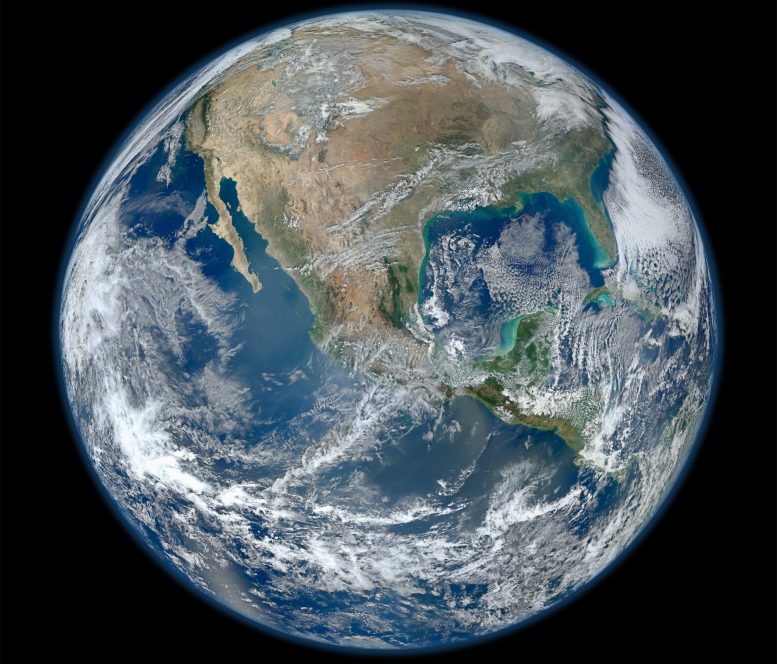
A ‘Blue Marble’ image of the Earth taken from the VIIRS instrument aboard NASA’s most recently launched Earth-observing satellite – Suomi NPP. This composite image uses a number of swaths of the Earth’s surface taken on January 4, 2012. Credit: NASA/NOAA/GSFC/Suomi NPP/VIIRS/Norman Kuring
New research presented at the 2014 Goldschmidt Geochemistry Conference reveals that the final stage of Earth’s formation is around 60 million years older than previously thought.
Sacramento, California, Tuesday, June 10, 2014 – Work presented today at the Goldschmidt Geochemistry Conference in Sacramento, California shows that the timing of the giant impact between Earth’s ancestor and a planet-sized body occurred around 40 million years after the start of solar system formation. This means that the final stage of Earth’s formation is around 60 million years older than previously thought.
Geochemists from the University of Lorraine in Nancy, France have discovered an isotopic signal which indicates that previous age estimates for both the Earth and the Moon are underestimates. Looking back into “deep time” it becomes more difficult to put a date on early Earth events. In part, this is because there is little “classical geology” dating from the time of the formation of the Earth – no rock layers, etc. So geochemists have had to rely on other methods to estimate early Earth events. One of the standard methods is measuring the changes in the proportions of different gases (isotopes) which survive from the early Earth.
Guillaume Avice and Bernard Marty analyzed xenon gas found in South African and Australian quartz, which had been dated to 3.4 and 2.7 billion years respectively. The gas sealed in this quartz is preserved as in a “time capsule”, allowing Avice and Marty to compare the current isotopic ratios of xenon, with those which existed billions of years ago. Recalibrating dating techniques using the ancient gas allowed them to refine the estimate of when the earth began to form. This allows them to calculate that the Moon-forming impact is around 60 million years (+/- 20 m. y.) older than had been thought.
Previously, the time of formation of the Earth’s atmosphere had been estimated at around 100 million years after the solar system’s formation. As the atmosphere would not have survived the Moon-forming impact, this revision puts the age up to 40 million years after the solar system formation (so around 60 million years older than previously thought).
According to Guillaume Avice:
“It is not possible to give an exact date for the formation of the Earth. What this work does is to show that the Earth is older than we thought, by around 60 million years.”
“The composition of the gases we are looking at changes according to the conditions they are found in, which of course depend on the major events in Earth’s history. The gas sealed in these quartz samples has been handed down to us in a sort of “time capsule”. We are using standard methods to compute the age of the Earth, but having access to these ancient samples gives us new data, and allows us to refine the measurement”.
“The xenon gas signals allow us to calculate when the atmosphere was being formed, which was probably at the time the Earth collided with a planet-sized body, leading to the formation of the Moon. Our results mean that both the Earth and the Moon are older than we had thought”.
Bernard Marty added,
“This might seem a small difference, but it is important. These differences set time boundaries on how the planets evolved, especially through the major collisions in deep time which shaped the solar system”.
The Goldschmidt Conference is the world’s leading annual conference on geochemistry. It takes place in Sacramento, California from 8-13 June 2014. http://goldschmidt.info/2014/.
Reference: “The iodine–plutonium–xenon age of the Moon–Earth system revisited” by G. Avice and B. Marty, 13 September 2014, Philosophical Transactions of the Royal Society A.
DOI: 10.1098/rsta.2013.0260









Be the first to comment on "Geochemists Reveal Earth’s Formation is Older Than Previously Thought"